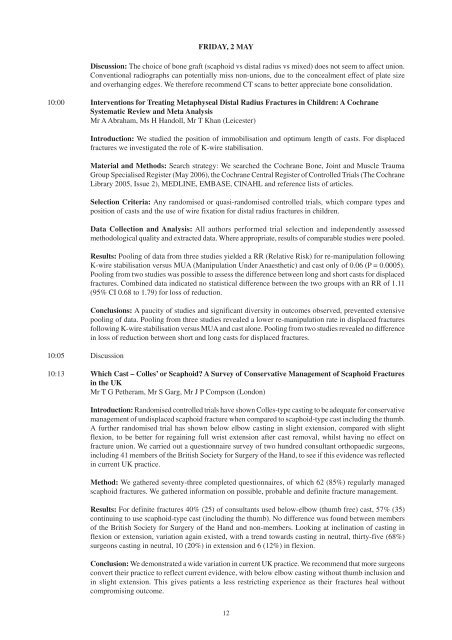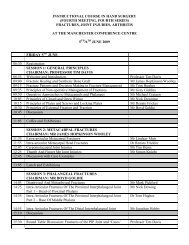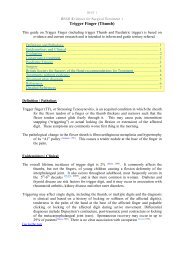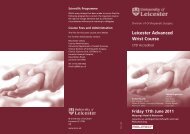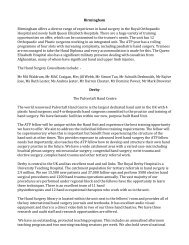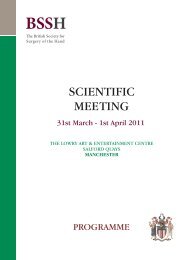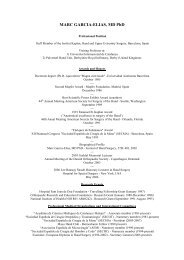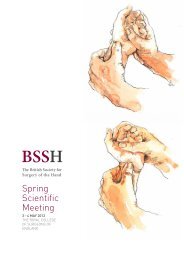here - The British Society for Surgery of the Hand
here - The British Society for Surgery of the Hand
here - The British Society for Surgery of the Hand
You also want an ePaper? Increase the reach of your titles
YUMPU automatically turns print PDFs into web optimized ePapers that Google loves.
Discussion: <strong>The</strong> choice <strong>of</strong> bone graft (scaphoid vs distal radius vs mixed) does not seem to affect union.<br />
Conventional radiographs can potentially miss non-unions, due to <strong>the</strong> concealment effect <strong>of</strong> plate size<br />
and overhanging edges. We t<strong>here</strong><strong>for</strong>e recommend CT scans to better appreciate bone consolidation.<br />
10:00 Interventions <strong>for</strong> Treating Metaphyseal Distal Radius Fractures in Children: A Cochrane<br />
Systematic Review and Meta Analysis<br />
Mr A Abraham, Ms H <strong>Hand</strong>oll, Mr T Khan (Leicester)<br />
10:05 Discussion<br />
FRIDAY, 2 MAY<br />
Introduction: We studied <strong>the</strong> position <strong>of</strong> immobilisation and optimum length <strong>of</strong> casts. For displaced<br />
fractures we investigated <strong>the</strong> role <strong>of</strong> K-wire stabilisation.<br />
Material and Methods: Search strategy: We searched <strong>the</strong> Cochrane Bone, Joint and Muscle Trauma<br />
Group Specialised Register (May 2006), <strong>the</strong> Cochrane Central Register <strong>of</strong> Controlled Trials (<strong>The</strong> Cochrane<br />
Library 2005, Issue 2), MEDLINE, EMBASE, CINAHL and reference lists <strong>of</strong> articles.<br />
Selection Criteria: Any randomised or quasi-randomised controlled trials, which compare types and<br />
position <strong>of</strong> casts and <strong>the</strong> use <strong>of</strong> wire fixation <strong>for</strong> distal radius fractures in children.<br />
Data Collection and Analysis: All authors per<strong>for</strong>med trial selection and independently assessed<br />
methodological quality and extracted data. W<strong>here</strong> appropriate, results <strong>of</strong> comparable studies were pooled.<br />
Results: Pooling <strong>of</strong> data from three studies yielded a RR (Relative Risk) <strong>for</strong> re-manipulation following<br />
K-wire stabilisation versus MUA (Manipulation Under Anaes<strong>the</strong>tic) and cast only <strong>of</strong> 0.06 (P = 0.0005).<br />
Pooling from two studies was possible to assess <strong>the</strong> difference between long and short casts <strong>for</strong> displaced<br />
fractures. Combined data indicated no statistical difference between <strong>the</strong> two groups with an RR <strong>of</strong> 1.11<br />
(95% CI 0.68 to 1.79) <strong>for</strong> loss <strong>of</strong> reduction.<br />
Conclusions: A paucity <strong>of</strong> studies and significant diversity in outcomes observed, prevented extensive<br />
pooling <strong>of</strong> data. Pooling from three studies revealed a lower re-manipulation rate in displaced fractures<br />
following K-wire stabilisation versus MUA and cast alone. Pooling from two studies revealed no difference<br />
in loss <strong>of</strong> reduction between short and long casts <strong>for</strong> displaced fractures.<br />
10:13 Which Cast – Colles’ or Scaphoid? A Survey <strong>of</strong> Conservative Management <strong>of</strong> Scaphoid Fractures<br />
in <strong>the</strong> UK<br />
Mr T G Pe<strong>the</strong>ram, Mr S Garg, Mr J P Compson (London)<br />
Introduction: Randomised controlled trials have shown Colles-type casting to be adequate <strong>for</strong> conservative<br />
management <strong>of</strong> undisplaced scaphoid fracture when compared to scaphoid-type cast including <strong>the</strong> thumb.<br />
A fur<strong>the</strong>r randomised trial has shown below elbow casting in slight extension, compared with slight<br />
flexion, to be better <strong>for</strong> regaining full wrist extension after cast removal, whilst having no effect on<br />
fracture union. We carried out a questionnaire survey <strong>of</strong> two hundred consultant orthopaedic surgeons,<br />
including 41 members <strong>of</strong> <strong>the</strong> <strong>British</strong> <strong>Society</strong> <strong>for</strong> <strong>Surgery</strong> <strong>of</strong> <strong>the</strong> <strong>Hand</strong>, to see if this evidence was reflected<br />
in current UK practice.<br />
Method: We gat<strong>here</strong>d seventy-three completed questionnaires, <strong>of</strong> which 62 (85%) regularly managed<br />
scaphoid fractures. We gat<strong>here</strong>d in<strong>for</strong>mation on possible, probable and definite fracture management.<br />
Results: For definite fractures 40% (25) <strong>of</strong> consultants used below-elbow (thumb free) cast, 57% (35)<br />
continuing to use scaphoid-type cast (including <strong>the</strong> thumb). No difference was found between members<br />
<strong>of</strong> <strong>the</strong> <strong>British</strong> <strong>Society</strong> <strong>for</strong> <strong>Surgery</strong> <strong>of</strong> <strong>the</strong> <strong>Hand</strong> and non-members. Looking at inclination <strong>of</strong> casting in<br />
flexion or extension, variation again existed, with a trend towards casting in neutral, thirty-five (68%)<br />
surgeons casting in neutral, 10 (20%) in extension and 6 (12%) in flexion.<br />
Conclusion: We demonstrated a wide variation in current UK practice. We recommend that more surgeons<br />
convert <strong>the</strong>ir practice to reflect current evidence, with below elbow casting without thumb inclusion and<br />
in slight extension. This gives patients a less restricting experience as <strong>the</strong>ir fractures heal without<br />
compromising outcome.<br />
12


